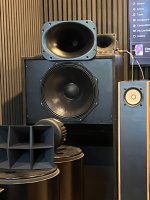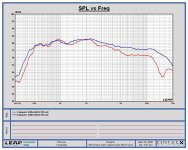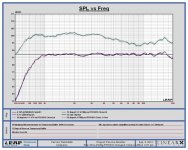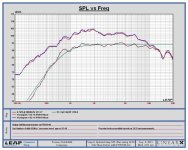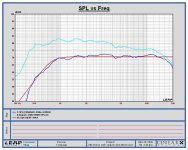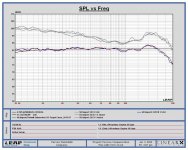He did not advice against it. He pointed out that you can buy used drivers in a rough condition, be sure to have pictures of the insides and whatever details you can get. Still if you are unlucky and get a driver that has taken physical abuse they might be damaged beyond repair, fx old jbl Alnico motors (pre 245x) are fragile to impacts.While my total speaker budget is healthy, the total cost for new JBL Be drivers would be ~ $5K. So, Marco said to get a used pair of 2450J and the Be diaphragms from USSpeaker for ~ $2.3K. But Troy would have to agree to restore them and do the diaphragm swap, but WelterSys advises against this surgery.
Meaning if you buy a set of 2450s test them/check them out, else deal with possible return etc. and buy another pair if you are unlucky.
Changing diaphragms can be done in a reliable manner. There are others who will do it for a free in a professional way.
They will perform very well and easy out to 16k, beyond that the level needs some compensation or a Tweter if you care or can hear it.
You could also buy through a second hand dealer that check and state the conditions before sales, but it comes with a cost $. Jammin Jersey fx, no website anymore though so need to contact.
If your interested in hearing some large format beryllium systems and you are in NY.So, the only practical (for non-DIYers) way to proceed for eliminating guesswork is to audition those few speakers which I was invited to hear and which locations are reachable
Hannover MA is not that far off?
Check out Professional Audio Design inc (PAD) They have also had frequent exhibit, events in NY, open tours to listening rooms etc, just check they're Facebook page, or instagram if you have that etc.
They are the official US distributor for TAD, and Augspurger monitors.
Meaning different biradial horns and TAD TD-4001,2002,ET-703A, woofers, and Augspurgers variant of the Radian 950be.
Also TAD's coaxial hifi products.
Both businesses are located in the same block in Hannover MA.
They also do studio work , acoustics etc.
As for your 745Be i'm not familiar with it beyond information on the forums and fx:
https://audioxpress.com/article/the-745neobe-compression-driver-from-radian-audio
It seems to have a well behaved response, and a smooth decay all the way to the top end, with a slight resonance at 18-20k.
Should not be too hard to handle with a xo in many cases.
Nothing that stands out as bad. The Be foil with PE surround, is well damped and drops off without objectioanble behavior. The inductance helps drop down the top end down , being doubled at 20k.
The phaseplug /throat design sets the best throat for the horn as all drivers, and they are a insepearable system.
As any 3" driver it will not be as comfortable at 5-600 hz as a larger diaphragm in general if all else is equal.
If you need the low xo as you have stated, then a large format driver 3/4" VC and 2/1,5/1,4 exit is where you want to look.
The 1,4" exit 2,5in VC SB 65 CDN-t is made to be used all the way without a tweeter.
In nature it is most similar to your Radian 745, but with a smaller VC and diaphragm from Ti.
The response is more extended then the 745, but there is more HF resonant energy .
While the DCM50 is 2" exit, more similar to a cone midrange compression driver, going lower and limited in extension.
Using a composite diaphragm with a 2" central coil, it will be the driver with the least clean decay in the useable range.
The JA6681B /MS1401 is also a 1,4" exit dome midrange driver, again with a 2,5in VC, with a delicate suspension and no replacements.
Notice your reviewer removed the internal throat extension so it became a 1" exit.
Very clean and wel behaved through it's range but requires a tweeter, goes to 10k.
Have replacement drivers, and dont stretch the power on it.
The JBL's are worthy mentions.
The 243x range 3" vc , 1,5" exit is incredibly effiicient in the lower range, but are stretched to give output at 20k, even with resonant TI hf breakup.
Notice the 2435 was designed to reach 15khz. They are very compact lightweight, ferrofluid. in the gap. And a very short and unusual phase plug, different from the 245x family.
The 245x range is better suited for a low 5-600hz xo.
2450H/J are 2" exit with the snout "throat adapters" very similar to the 2450SL and 2451 just with a extension and no standard bcd for horns.
The internal throat and loading lets it go lower with the right horn, but it punishes the high end, better suited for a 3-way.
I believe the MS2001 versions used alu diaphragms.
While the 1,5" exit 2450sl, 2451 (and they're variants) have a 0 degree exit with the coherent wave phaseplug ending at the throat.
And are better suited for a 2 way design and also have more freedom in choice of horn/waveguide geometries.
ALso the DAS copies will perform similar with the same diaphragms.
Else the 18S ND4015 4" diaphragm 1,5" exit stands out as a excellent choice, i suspect Docali would highly agree.
The prices are not pleasant with a Be diaphragm.
Will go lower then the ND3 and 1460/1480 variants comfortably, which are out of theyre ideal range below 7-800hz.
1480 is the more robust variant of the 2. the ND3 is a more refined design with less distortion and hf decay.
Those 2 again with a 3" vc ,4" exit with Be diaphragms are really similar to what you already have, and mr. Crowe reviewed the 1480 also.
The Faital HF1440 3,4" VC 1,4" exit is a worthy candidate, needs some work smoothen it's lower end response.
The 1460 again is out of it's best range after 7-900hz, and does not extend as low naturally.
The Radian 951 1,4", and 950 2" will do with the pros and cons from those.
They will go low and can easily be shimmed a tiny bit if needed.
The TAD TD-400X 2"/ 39mm family, of 4"Vc drivers again will do what you were asking for.
With some different tradeoffs between the models.
IF you define what you want to do in terms of 2 or 3 way.
Your spl needs.
It will be a lot easier to give advice.
A higher xo gives more choice in drivers, a tweeter also does but complicates the design in many ways.
600hz is also unusually low for a 15/16" when it comes to matching it to the dispersion of horn.
This thread and others on here have covered most of these drivers extensively many times.
Last edited:
With all the discussion about JBL drivers I am surprised the SL coated diaphragm's don't seem to be in the mix aside from a brief mention. The 2431/2435 drivers were uncoated S/R drivers Aluminum and Be. When incorporated into the Array 880/1400 and 9800 systems they were coated with aquaplas. This coating makes a difference and improves the CSD time domain performance.
The 2450's 1.5 and 2 inch have SL/coated diaphragm's available. The 1.5" throat versions can go out to 20k without + EQ and are much better behaved than the uncoated versions. I have no experience with 2" versions and horns/waveguides.
A cheaper alternative to Be as a start. You mike like the SL's enough to forgo the Be conversion. With a 4" Be there is a good chance you may want to add a tweeter to the mix adding cost and complexity.
Rob 🙂
The 2450's 1.5 and 2 inch have SL/coated diaphragm's available. The 1.5" throat versions can go out to 20k without + EQ and are much better behaved than the uncoated versions. I have no experience with 2" versions and horns/waveguides.
A cheaper alternative to Be as a start. You mike like the SL's enough to forgo the Be conversion. With a 4" Be there is a good chance you may want to add a tweeter to the mix adding cost and complexity.
Rob 🙂
Last edited:
After trying many drivers and horns, the JBL 2452 with Aqualplas diaphragms on the JBL 2384 horn is what I settled on. It does most things right and just gets out of the way. Someday I might upgrade to Be but I’m in no rush.
I went from AH-450 12 sided conicals, to Tractrix 600, 550Hz and even 400 cutoff horns, then to Le Cléach 550Hz profiles and then back to conicals with Danley MEH SH50s all on the same Vitavox S2 drivers.
It's been a great journey.
I first tried foam pipe insulation on the AH horns to round the mouths.
The Tractrix and Le Cléach especially are much more rounded.
The round over mouth profiles work nicely but increase room interaction / interference.
I used sound deadening wall treatment.
The narrower throats that Tractrix and to a lesser extent Le Cléach have, did at times sound a little coloured.
Not so the faster opening throat of the SH50s.
I'm planning a SH60 build next - just to see.
It's been a great journey.
I first tried foam pipe insulation on the AH horns to round the mouths.
The Tractrix and Le Cléach especially are much more rounded.
The round over mouth profiles work nicely but increase room interaction / interference.
I used sound deadening wall treatment.
The narrower throats that Tractrix and to a lesser extent Le Cléach have, did at times sound a little coloured.
Not so the faster opening throat of the SH50s.
I'm planning a SH60 build next - just to see.
Anyone have any experience with a Faital pro 1460 with a carbon fiber diaphragm?
Yep I’ve been using a faital pro hf1460 paired with faital lth142 horns in a simple 2-way setup for domestic music listening crossing at 650hz first order. Good balance between detail and refinement. Little boost in the highs via eq controls on the Deqx to give the treble energy that suits my taste. Its sound quality in some ways reminds me of the beyma tpl-150h.
Attachments
Hi @Robh3606
I have a recollection that there were some measurements comparing the Ti SL/coated diaphragm with a Be diaphragm, at the Lansing Heritage web-page, but I cannot find it.
Kindest regards,
M
Can you please restate the language " . . . can go out to 20k without + EQ . . ." as it seems to be contradictory? In other words does it need EQ or not? I am curious as I had acquired the 2450 SL, with the SL/coated diaphragm.The 1.5" throat versions can go out to 20k without + EQ and are much better behaved than the uncoated versions.
I have a recollection that there were some measurements comparing the Ti SL/coated diaphragm with a Be diaphragm, at the Lansing Heritage web-page, but I cannot find it.
Kindest regards,
M
Can you please restate the language " . . . can go out to 20k without + EQ . . ." as it seems to be contradictory? In other words does it need EQ or not? I am curious as I had acquired the 2450 SL, with the SL/coated diaphragm.
Hello
You have a 1.5" 2450SL ?
I meant additional EQ beyond the EQ from a passive crossover to flatten the response. Here are some examples 435Be vs 476Be and 2453Sl The Be's are more rolled off above 10K. The 476Mg has a rising response. You could extend the response a bit with a penalty in sensitivity.
The attached thread has comparisons as well. The Be is Truextent and not the stock 476 Be. I believe this may be the thread you were looking for with 2451 core.
Rob 🙂
https://www.audioheritage.org/vbull...-4-quot-Diaphragm-Comparisons&highlight=476Be
Attachments
Last edited:
Hi @Robh3606
In any event, thank you very much for your reply.
Kindest regards.
M
Yes, I do, with the Ti-SL diaphragm. That is, why I was intrigued by your post. I am friends with the gentleman who worked on a development of the Be diaphragm, and has some samples, so I have been curious whether I should get them.You have a 1.5" 2450SL ?
Ah, O.K., that makes sense now. I remember that the passive EQ was also posted somewhere with a discussion regarding the confusion/analysis of the capacitor(s)'s value used for the compensation. I will have to try to find it, unless, of course, you again have it on your fingertips. 😉I meant additional EQ beyond the EQ from a passive crossover to flatten the response.
Thank you for the thread, but it was not the one I remembered. But maybe I am confused, because the graphs I was referring to were the ones that you attached. Perhaps they were from your "Passive monitor" thread?I believe this may be the thread you were looking for with 2451 core.
In any event, thank you very much for your reply.
Kindest regards.
M
Ah, O.K., that makes sense now. I remember that the passive EQ was also posted somewhere with a discussion regarding the confusion/analysis of the capacitor(s)'s value used for the compensation. I will have to try to find it, unless, of course, you again have it on your fingertips. 😉
Hello
Hmm? I did an analysis of the 9900 network for what the series and parallel notches did with changes for conversion to use on the PTH1010 waveguide. If that's what you are looking for? Nothing recent with single cap values
Rob 🙂
https://www.audioheritage.org/vbull...nitor-Thread&highlight=passive+monitor+thread
Hi @Robh3606,
thank you for the reply.
No, that is not it. There was some discussion about the protection/equalization network, with pictures of the PCB, on which the components, I believe a resistor(s) and capacitor(s) were mounted. There was some confusion about the values. It might have been in one of the many M2 monitor threads. I will find it.
Kindest regards,
M
thank you for the reply.
No, that is not it. There was some discussion about the protection/equalization network, with pictures of the PCB, on which the components, I believe a resistor(s) and capacitor(s) were mounted. There was some confusion about the values. It might have been in one of the many M2 monitor threads. I will find it.
Kindest regards,
M
No, that is not it. There was some discussion about the protection/equalization network, with pictures of the PCB, on which the components, I believe a resistor(s) and capacitor(s) were mounted. There was some confusion about the values. It might have been in one of the many M2 monitor threads. I will find it.
The correct value is 3.3uf not 33.3uf
If this isn't it I give up!
Rob 🙂
https://www.audioheritage.org/vbull...ect-M2-DIY-Thread/page2&highlight=passive+pcb
Attachments
Hi @Robh3606,
Kindest regards,
M
I do not care what they say about you, you are awesome. This is it.The correct value is 3.3uf not 33.3uf
Kindest regards,
M
Using the Ciare PR614 myself. Fantastic horn!
No audible or measured ringing; resonances? Seating distance? Please describe all aspects of sound stage.
By direct, do you mean that the horns provide a more "they are here" sound rather than an "I am there at the event" sound?The Ciares sound clearer to my ears. They don't have the Biradial Vertical Squash Geometry Technology (BVSGT) which I think attributes to a more direct presentation in the case of the Ciares.
Have you ever heard the PR614 https://www.usspeaker.com/ciare pr614-1.htm , or by judging from its directivity plots is it possible to predict if it projects a wide and deep sound stage for a given size room?The PR614, is a 60x40 horn, that means you will have to cross that 12" fairly high up in frequency if you want a good directivity match and power response at XO.
My room is ~ 3000 cu ft, triangular ceiling that peaks at 11 ft. Room is mostly empty except for a flat TV, small open glass table, two chairs and four Rythmik F12 subs.
Beryllium production is increasing but the audiophile market being a niche, it is almost impossible to get brand new beryllium compression driver. For example latest 18 sound beryllium cd is unavailable from tlhp. And the latest prices were as insane as vintage TAD products.
The current issue is largely because Materion cancelled production of some foil thicknesses last year. So it is a supply issue from one source really.
And yes the audio market is small compared to radiology and other markets ehrn it comes to Be
For Radian Ai and Be driver owners and NicoB of https://audiohorn.net/ and Arnaud Le Gac of https://alg-audiodesign.com/pavillons/ find drivers like https://www.usspeaker.com/radian 745neoBepb-1.htm , how likely are their complaints of drivers like the 745 sounding "hard" or "hashy" due to the need for adding a precisely measured contouring filter? Pierre designed and added one to flatten and extend the 745Be's HF response, apparently with very satisfying results. See post 15266, 15276.
https://www.diyaudio.com/community/threads/beyond-the-ariel.100392/post-7481975
No, a correctly designed filter applied to a problem that is correctable, should be fine.how likely are their complaints of drivers like the 745 sounding "hard" or "hashy" due to the need for adding a precisely measured contouring filter?
So, you're saying that if NicoB and Arnaud heard the 745Be driver with Pierre's apparently perfect contouring filter they would not hear any hash or hardness?No, a correctly designed filter applied to a problem that is correctable, should be fine.
Or if NicoB and Arnaud never listening to that driver with any kind of filter that fixed its ragged HF response. Perhaps if Gary had reached out to Pierre to get the filter done right he'd still be use those drivers, but I'm sure he did his best on his own before swapping out the Radians for the Yamahas. https://www.diyaudio.com/community/threads/compression-driver-impedance-question.318749/post-5352494
- Home
- Loudspeakers
- Multi-Way
- Best Compression Drivers today 2022?
